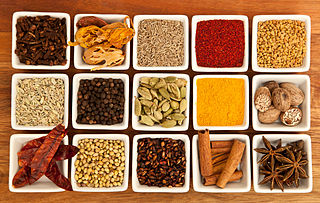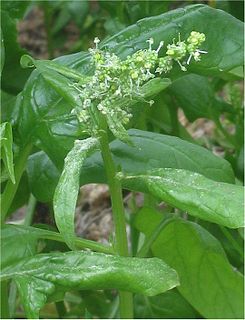Sevpuri | |
| Place of origin | India |
|---|---|
| Region or state | Maharashtra |
| Main ingredients | Puri, Sev, potatoes, onions, chutneys |
| Variations | Bhelpuri, Dahipuri, Pani Puri, Sev papdi chaat |
Sev puri is an Indian snack and a type of chaat. [1] It is a speciality that originates from Mumbai, Maharashtra. [2]

Indian cuisine consists of a wide variety of regional and traditional cuisines native to the Indian subcontinent. Given the range of diversity in soil type, climate, culture, ethnic groups, and occupations, these cuisines vary substantially from each other and use locally available spices, herbs, vegetables, and fruits. Indian food is also heavily influenced by religion, in particular Hindu, cultural choices and traditions. The cuisine is also influenced by centuries of Islamic rule, particularly the Mughal rule. Samosas and pilafs can be regarded as examples.

Chaat is a savory snack that originated in India, typically served as an hors d'oeuvre at roadside tracks from stalls or food carts across the Indian subcontinent in India, Pakistan, Nepal and Bangladesh. With its origins in Uttar Pradesh, India, chaat has become immensely popular in the rest of the Indian subcontinent. The word derives from Hindi cāṭ चाट, from cāṭnā चाटना, from Prakrit caṭṭei चट्टेइ.

Mumbai is the capital city of the Indian state of Maharashtra. It is the most populous city in India with an estimated city proper population of 12.4 million as of 2011. Along with the neighbouring regions of the Mumbai Metropolitan Region, it is the second most populous metropolitan area in India, with a population of 21.3 million as of 2016. Mumbai lies on the Konkan coast on the west coast of India and has a deep natural harbour. In 2008, Mumbai was named an alpha world city. It is also the wealthiest city in India, and has the highest number of millionaires and billionaires among all cities in India. Mumbai is home to three UNESCO World Heritage Sites: the Elephanta Caves, Chhatrapati Shivaji Maharaj Terminus, and the city's distinctive ensemble of Victorian and Art Deco buildings.
Contents
In Mumbai and Pune, sev puri is strongly associated with street food, but is also served at upscale locations. [1] Recently, supermarkets have started stocking ready-to-eat packets of sev puri and similar snacks like bhelpuri. [3]

Pune, formerly spelled Poona (1857–1978), is the second largest city in the Indian state of Maharashtra, after Mumbai. It is the ninth most populous city in the country with an estimated population of 3.13 million. Along with its Industrial Estate Pimpri Chinchwad and the three cantonment towns of Pune, Khadki and Dehu Road, Pune forms the urban core of the eponymous Pune Metropolitan Region (PMR). According to the 2011 census, the urban area has a combined population of 5.05 million while the population of the metropolitan region is estimated at 7.27 million.

Street food is ready-to-eat food or drink sold by a hawker, or vendor, in a street or other public place, such as at a market or fair. It is often sold from a portable food booth, food cart, or food truck and meant for immediate consumption. Some street foods are regional, but many have spread beyond their region of origin. Most street foods are classed as both finger food and fast food, and are cheaper on average than restaurant meals. According to a 2007 study from the Food and Agriculture Organization, 2.5 billion people eat street food every day.

Bhelpuri is a savoury snack, originating from the Indian subcontinent, and is also a type of chaat. It is made of puffed rice, vegetables and a tangy tamarind sauce.




















